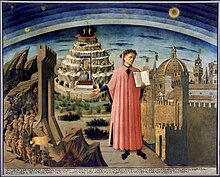 Dante shown holding a copy of the Divine Comedy, next to the entrance to Hell, the seven terraces of Mount Purgatory and the city of Florence, with the spheres of Heaven above, in Domenico di Michelino's 1465 fresco | |
| Author | Dante Alighieri |
|---|---|
| Language | Italian |
| Genre | narrative poem |
Publication date | c. 1321 |
| Publication place | Italy |
| Text | Divine Comedy at Wikisource |
The Divine Comedy (Italian: Divina Commedia [diˈviːna komˈmɛːdja]) is an Italian narrative poem by Dante Alighieri, begun c. 1308 and completed around 1321, shortly before the author's death. It is widely considered the pre-eminent work in Italian literature[1] and one of the greatest works of Western literature. The poem's imaginative vision of the afterlife is representative of the medieval worldview as it existed in the Western Church by the 14th century. It helped establish the Tuscan language, in which it is written, as the standardized Italian language.[2] It is divided into three parts: Inferno, Purgatorio, and Paradiso.
The poem discusses "the state of the soul after death and presents an image of divine justice meted out as due punishment or reward",[3] and describes Dante's travels through Hell, Purgatory, and Heaven. Allegorically, the poem represents the soul's journey towards God, beginning with the recognition and rejection of sin (Inferno), followed by the penitent Christian life (Purgatorio), which is then followed by the soul's ascent to God (Paradiso). Dante draws on medieval Catholic theology and philosophy, especially Thomistic philosophy derived from the Summa Theologica of Thomas Aquinas.
In the poem, the pilgrim Dante is accompanied by three guides: Virgil, who represents human reason, and who guides him for all of Inferno and most of Purgatorio; Beatrice, who represents divine revelation[4] in addition to theology, grace, and faith; and guides him from the end of Purgatorio onwards; and Saint Bernard of Clairvaux, who represents contemplative mysticism and devotion to Mary the Mother, guiding him in the final cantos of Paradiso.
The work was originally simply titled Comedìa (pronounced [komeˈdiːa], Tuscan for "Comedy") – so also in the first printed edition, published in 1472 – later adjusted to the modern Italian Commedia. The adjective Divina was added by Giovanni Boccaccio,[5] owing to its subject matter and lofty style, and the first edition to name the poem Divina Comedia in the title was that of the Venetian humanist Lodovico Dolce,[6] published in 1555 by Gabriele Giolito de' Ferrari.
- ^ For example, Encyclopedia Americana, 2006, Vol. 30. p. 605: "the greatest single work of Italian literature;" John Julius Norwich, The Italians: History, Art, and the Genius of a People, Abrams, 1983, p. 27: "his tremendous poem, still after six and a half centuries the supreme work of Italian literature, remains – after the legacy of ancient Rome – the grandest single element in the Italian heritage;" and Robert Reinhold Ergang, The Renaissance, Van Nostrand, 1967, p. 103: "Many literary historians regard the Divine Comedy as the greatest work of Italian literature. In world literature it is ranked as an epic poem of the highest order."
- ^ See Lepschy, Laura; Lepschy, Giulio (1977). The Italian Language Today. Or any other history of Italian language.
- ^ Vallone, Aldo. "Commedia" (trans. Robin Treasure). In: Lansing (ed.), The Dante Encyclopedia, pp. 181–184.
- ^ Emmerson, Richard K., and Ronald B. Herzman. "Revelation". In: Lansing (ed.), The Dante Encyclopedia, pp. 742–744.
- ^ "Divina Commedia". Enciclopedia Italiana (in Italian). Archived from the original on 18 February 2021. Retrieved 19 February 2021.
- ^ Ronnie H. Terpening, Lodovico Dolce, Renaissance Man of Letters (Toronto, Buffalo, London: University of Toronto Press, 1997), p. 166.